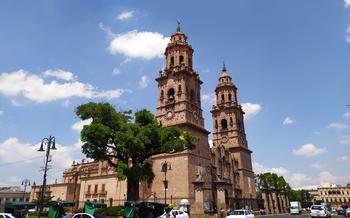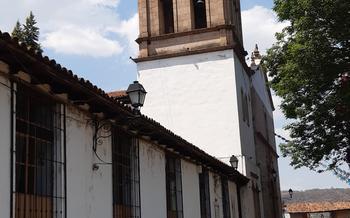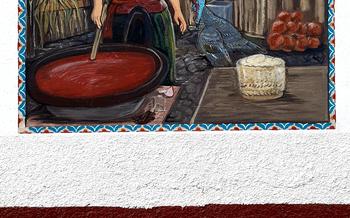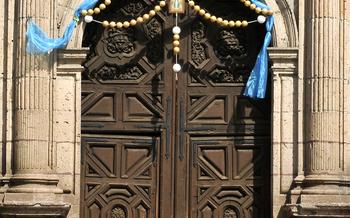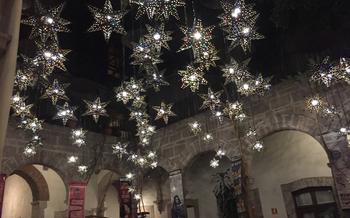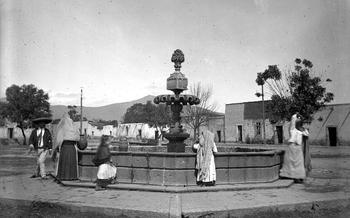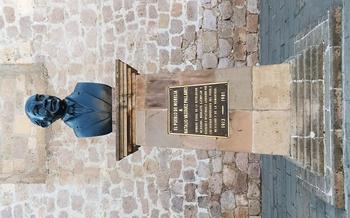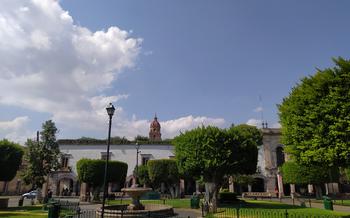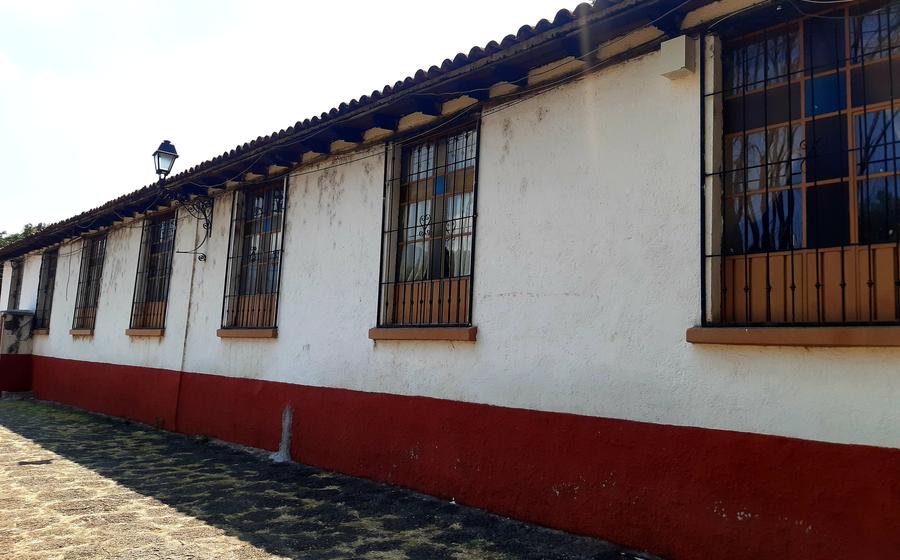
Museo de Sitio de la Zona Arqueológica de Tzintzuntzan
- The Museo de Sitio de la Zona Arqueológica de Tzintzuntzan: A Window into the Tarascan Civilization
- Unveiling the Treasures of the Tarascan Empire:
- A Walk Through Time: Exploring the Museum's Galleries
- The Ceremonial Center of Tzintzuntzan: A Spiritual and Political Hub
- The Yácatas: Symbols of Power and Prestige
- The Ballcourt: A Ritualistic Arena
- The Skull Racks: A Window into Tarascan Beliefs
- The Ancient City of Tzintzuntzan: A Thriving Metropolis
- The Museum's Contribution to Archaeological Research
- The Museum's Educational Programs and Outreach
- Exploring the Surrounding Area: Morelia and Beyond
- The Museum's Significance in the Context of Mexican History
- Preservation and Conservation Efforts at the Museum
The Museo de Sitio de la Zona Arqueológica de Tzintzuntzan: A Window into the Tarascan Civilization
The Museo de Sitio de la Zona Arque the ancient city of Tzintzuntzan, the museum's striking architectural design and layout create a stimulating environment for visitors to explore the diverse collection of artifacts and exhibits.
The museum's collection encompasses an array of significant artifacts, including pottery, jewelry, sculptures, and ceremonial objects, providing a comprehensive overview of the daily life, rituals, and beliefs of the Tarascan people. These artifacts showcase the remarkable artistic achievements of the Tarascan civilization and offer valuable insights into their social and political organization.
The relevance of the Museo de Sitio de la Zona Arqueológica de Tzintzuntzan lies in its role as a guardian of the Tarascan legacy. The museum serves as a repository of knowledge, preserving and showcasing the cultural heritage of a civilization that played a significant role in shaping the history and identity of the region.
Unveiling the Treasures of the Tarascan Empire:
The Museo de Sitio de la Zona Arqueológica de Tzintzuntzan houses a remarkable collection of artifacts and exhibits that provide a glimpse into the daily life, rituals, and cultural practices of the Tarascan people. Visitors can marvel at intricate pottery, finely worked jewelry, and impressive sculptures that showcase the artistic prowess of this ancient civilization. The museum also features detailed dioramas and interactive displays that bring to life the vibrant markets, religious ceremonies, and political gatherings that once took place in Tzintzuntzan. Through these exhibits, visitors gain a deeper understanding of the complex social structure, economic system, and belief system of the Tarascan civilization. The museum's collection serves as a testament to the enduring legacy of the Tarascan people and their significant contributions to the cultural heritage of Mexico.
A Walk Through Time: Exploring the Museum's Galleries
The Museo de, each showcasing a different aspect of the Tarascan civilization. The first gallery provides an overview of the history and culture of the Tarascan people, with artifacts such as pottery, tools, and weapons. The second gallery focuses on the daily life of the Tarascan people, displaying items such as clothing, jewelry, and household objects. The third gallery explores the religious beliefs and practices of the Tarascan people, with exhibits on their gods, temples, and rituals. The fourth gallery is dedicated to the political and military organization of the Tarascan Empire, featuring artifacts such as armor, weapons, and insignia.
The museum's galleries are arranged chronologically, allowing visitors to trace the evolution of the Tarascan culture over time. Interactive elements and multimedia presentations enhance the visitor experience, providing additional information and insights into the Tarascan civilization. The museum also offers guided tours, led by knowledgeable experts who can provide further context and answer any questions visitors may have.
The Ceremonial Center of Tzintzuntzan: A Spiritual and Political Hub
The ceremonial center of Tzintzuntzan served as the very heart of the Tarascan Empire, radiating both spiritual and political authority. This sacred site was the stage for elaborate religious ceremonies, where the Tarascan rulers and priests performed rituals to honor their deities and ensure the well-being of their people. Here, the sacred and the political intertwined, creating a powerful nexus of power and spirituality.
The architectural wonders of the ceremonial center are a testament to the ingenuity and craftsmanship of the Tarascan people. Towering temples, expansive plazas, and impressive pyramids dominate the landscape, each structure serving a distinct purpose. The main temple, known as the Templo Mayor, stands as a symbol of the empire's grandeur and religious devotion. Its imposing presence reflects the centrality of religion in Tarascan society.
The layout of the ceremonial center was carefully designed to enhance its sacred ambiance. Pathways and alignments were meticulously planned to create sightlines and vistas that connected the various structures and emphasized their significance. The integration of the ceremonial center with the surrounding environment further underscores the Tarascan's reverence for nature and their belief in the interconnectedness of all things.
The Yácatas: Symbols of Power and Prestige
The yácatas, or ceremonial platforms, are among the most distinctive features of the archaeological site of Tzintzuntzan. These monumental structures, built using large stone blocks, served as platforms for temples and other religious structures. Their unique architectural features, including their stepped sides, sloping ramps, and elaborately carved facades, set them apart from other pre-Columbian structures in the region.
The construction techniques and materials used in building the yácatas demonstrate the engineering prowess of the Tarascan civilization. The massive stone blocks were carefully cut and fitted together without the use of mortar, creating stable and durable structures. The yácatas were often decorated with intricate carvings and sculptures, depicting religious symbols, historical events, and important figures from Tarascan mythology.
The symbolic significance of the yácatas extended beyond their practical function as platforms for temples. They were considered sacred spaces, representing the connection between the earthly and spiritual realms. The yácatas were used for a variety of religious ceremonies and rituals, including offerings to the gods, prayers for rain, and celebrations of important festivals.
The yácatas stand as a testament to the power and prestige of the Tarascan civilization. Their imposing size and elaborate decoration reflect the wealth and influence of the Tarascan rulers, who used these structures to assert their authority and reinforce their connection to the divine. The yácatas continue to captivate visitors with their grandeur and beauty, offering a glimpse into the rich cultural and religious traditions of the Tarascan people.
The Ballcourt: A Ritualistic Arena
In the heart of the ceremonial center, visitors can find the ballcourt, a significant feature in Mesoamerican cultures. It served as a ritualistic arena where the ancient Tarascan people played the sacred ballgame, known as ulama. The ballcourt consists of two long, narrow playing fields separated by a central line. The walls on either side of the fields have stone rings embedded into them. These rings were used as targets, and the objective of the game was to hit the ball through one of these rings.
The ballgame was more than just a sport; it had deep religious and symbolic meanings. It represented the struggle between opposing forces, such as light and darkness, good and evil. The game also had political significance, as it was often played to settle disputes or to determine the outcome of important events.
The ballgame was played with a heavy, solid rubber ball, which was often made from the sap of the Castilla elastica tree. The players wore protective gear, such as helmets and gloves, to protect themselves from the hard ball. The game was played barefoot, and the players used their hips, elbows, and forearms to hit the ball.
The ballcourt at Tzintzuntzan is one of the largest and best-preserved in Mexico. It measures approximately 200 feet long and 100 feet wide. The walls are made of stone and are decorated with intricate carvings. The ballcourt is a testament to the skill and artistry of the Tarascan people.
The Skull Racks: A Window into Tarascan Beliefs
The Museo de skulls that offer a glimpse into the beliefs and rituals of the Tarascan civilization. These skulls were displayed on racks, or tzompantli, as a symbol of power and prestige. The practice of displaying skulls was common in Mesoamerican cultures, and the Tarascan people believed that the skulls held the spirits of the deceased. The tzompantli served as a reminder of the power of death and the importance of honoring the ancestors.
The museum's collection of skulls includes those of both men and women, and they exhibit a variety of modifications. Some skulls have been drilled or cut, while others have been painted or decorated. These modifications suggest that the skulls were used in rituals and ceremonies. The museum also displays a number of ceramic replicas of skulls, which were used to represent the deceased in burials.
The skull racks at the Museo de Sitio de la Zona Arqueológica de Tzintzuntzan are a powerful reminder of the Tarascan people's beliefs about death and the afterlife. They offer a unique insight into the culture and history of this ancient civilization.
The Ancient City of Tzintzuntzan: A Thriving Metropolis
In its heyday, Tzintzuntzan was a bustling metropolis, home to a thriving population that engaged in diverse economic activities and maintained extensive trade networks. The city's strategic location at the crossroads of several important trade routes made it a focal point for commerce and exchange. The Tarascan people were skilled merchants, trading their wares with neighboring regions and even distant lands. The city's markets were a hive of activity, with merchants from all corners of the empire converging to trade their goods. Tzintzuntzan's prosperity was also fueled by its agricultural prowess. The fertile lands surrounding the city produced abundant crops, which sustained its large population and supported its economic growth. The city's impressive size, layout, and population density are a testament to the sophistication and organizational skills of the Tarascan civilization. Its thriving economy and extensive trade networks demonstrate the vibrant and interconnected nature of pre-Columbian Mesoamerican societies.
The Museum's Contribution to Archaeological Research
The Museo de Sitio de la Zona Arqueológica de Tzintzuntzan plays a vital role in preserving and studying the artifacts from Tzintzuntzan. The museum houses a vast collection of archaeological findings, including ceramics, stone tools, jewelry, and skeletal remains, which provide valuable insights into the daily life, rituals, and beliefs of the Tarascan people. Through ongoing archaeological research conducted at the site, the museum's team of experts continues to uncover new information about the Tarascan civilization and its cultural significance. The museum collaborates with other institutions and scholars both nationally and internationally to share knowledge and foster a deeper understanding of this ancient civilization. The research conducted at the museum contributes significantly to the broader field of Mesoamerican archaeology and helps to shed light on the rich cultural tapestry of Mexico's past.
The Museum's Educational Programs and Outreach
The Museo de Sitio de la. It offers a range of educational programs and workshops designed to foster a deeper understanding of Tarascan culture and history. These programs cater to students of all ages, from primary school children to university students. The museum also conducts workshops and seminars for teachers, providing them with resources and knowledge to incorporate Tarascan history into their classrooms.
The museum's outreach initiatives extend beyond its walls, reaching communities throughout Michoacán and beyond. It collaborates with local schools and community centers to organize cultural events, exhibitions, and lectures. These initiatives aim to raise awareness of Tarascan culture and promote a sense of cultural pride and identity among the local population.
The museum also plays a crucial role in fostering cultural tourism in the region. By showcasing the rich heritage of the Tarascan civilization, the museum attracts visitors from around the world, contributing to the economic development of the region. The museum's educational programs and outreach initiatives not only enrich the lives of local communities but also contribute to the preservation and promotion of Mexico's cultural heritage.
Exploring the Surrounding Area: Morelia and Beyond
Beyond the Museo de Sitio de la Zona Arqueológica de Tzintzuntzan, the city of More Heritage Site renowned for its well-preserved colonial architecture, vibrant cultural scene, and delicious cuisine. Must-see attractions include the Morelia Cathedral, a masterpiece of Baroque architecture, and the Templo de San Francisco, with its stunning frescoes and intricate facade. Visitors can also explore the city's many museums, art galleries, and theaters, or simply wander through the charming cobblestone streets and admire the colonial mansions.
For those seeking a taste of nature, the region surrounding Morelia offers plenty of options. The nearby Paricutin Volcano National Park is home to the youngest volcano in North America, while the Monarch Butterfly Biosphere Reserve provides a sanctuary for millions of monarch butterflies during their winter migration.
Day trips from Morelia can take you to picturesque towns and villages such as Pátzcuaro, Quiroga, and Cuitzeo, each with its own unique charm and attractions. Visitors can explore local markets, sample traditional dishes, and immerse themselves in the region's rich cultural heritage.
When it comes to dining, Morelia offers a diverse culinary scene with something to suit every taste. From traditional Mexican cuisine to international fare, there are plenty of restaurants to choose from. Be sure to try local specialties such as carnitas, enchiladas, and uchepos, a traditional soup made with corn, beans, and squash.
For accommodation, Morelia offers a range of options, from budget-friendly hostels to upscale hotels and haciendas. Whether you're a solo traveler, a couple, or a family, you'll find something to meet your needs and budget.
The Museum's Significance in the Context of Mexican History
The Museo de Sitio de la Zona Arqueológica de Tzintzuntzan holds immense significance in the context of Mexican history, serving as a custodian of the nation's rich cultural heritage. This museum stands as a testament to the ingenuity and artistry of pre-Columbian civilizations, particularly the Tarascan Empire. Its collection offers invaluable insights into the daily lives, rituals, and beliefs of this ancient society.
The museum's exhibits play a crucial role in preserving and showcasing Mexico's diverse cultural tapestry. They highlight the unique contributions of the Tarascan civilization to Mexican history, showcasing their advanced knowledge of astronomy, engineering, and metallurgy. Moreover, the museum serves as a reminder of the rich cultural diversity that existed in Mexico prior to the arrival of the Spanish.
The Museo de Sitio de la Zona Arqueológica de Tzintzuntzan is not merely a repository of artifacts; it is a symbol of national pride and identity. It stands as a testament to the resilience and creativity of the Mexican people, who have preserved their cultural heritage despite centuries of colonial rule and globalization. The museum's existence is a celebration of Mexico's rich past and a source of inspiration for future generations.
Preservation and Conservation Efforts at the Museum
The Museo de Sitio de la Zona artifacts and exhibits. The museum employs various conservation techniques and practices to protect the fragile remains of the Tarascan civilization. These include climate control, proper storage, and regular monitoring to prevent damage from humidity, light, and pests.
One of the challenges faced by the museum is the need to balance preservation with accessibility. The museum wants to make its collection available to the public, but it also needs to ensure that the artifacts are not damaged by excessive handling or exposure to harmful elements. To address this challenge, the museum has implemented a system of controlled access and display, limiting the number of visitors allowed in certain areas and using protective barriers to prevent direct contact with the artifacts.
Despite the challenges, the museum remains committed to preserving and conserving its collection for future generations. The museum staff works diligently to ensure that the artifacts are properly cared for and displayed in a way that respects their historical and cultural significance. Public support and funding are essential for the museum to continue its conservation efforts. Visitors can contribute to the museum's preservation work by making donations, attending fundraising events, and spreading awareness about the importance of protecting Mexico's cultural heritage.

